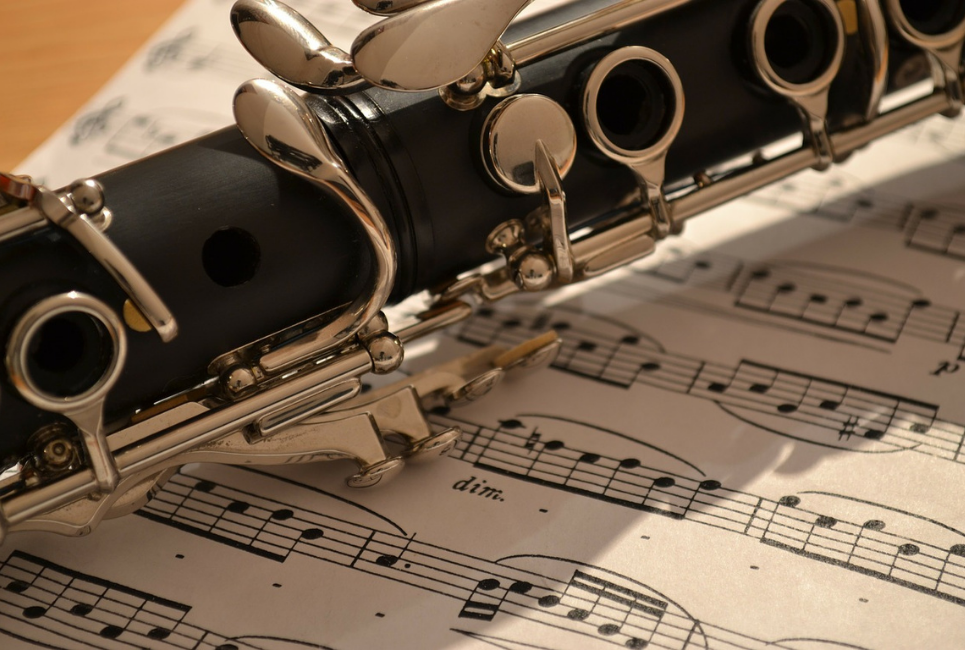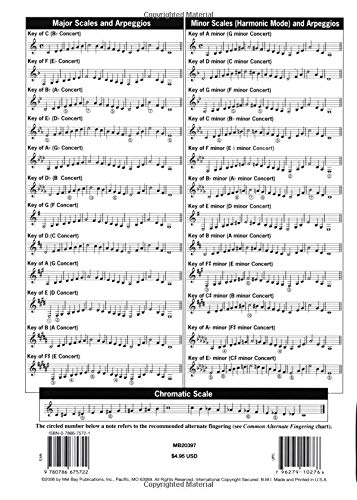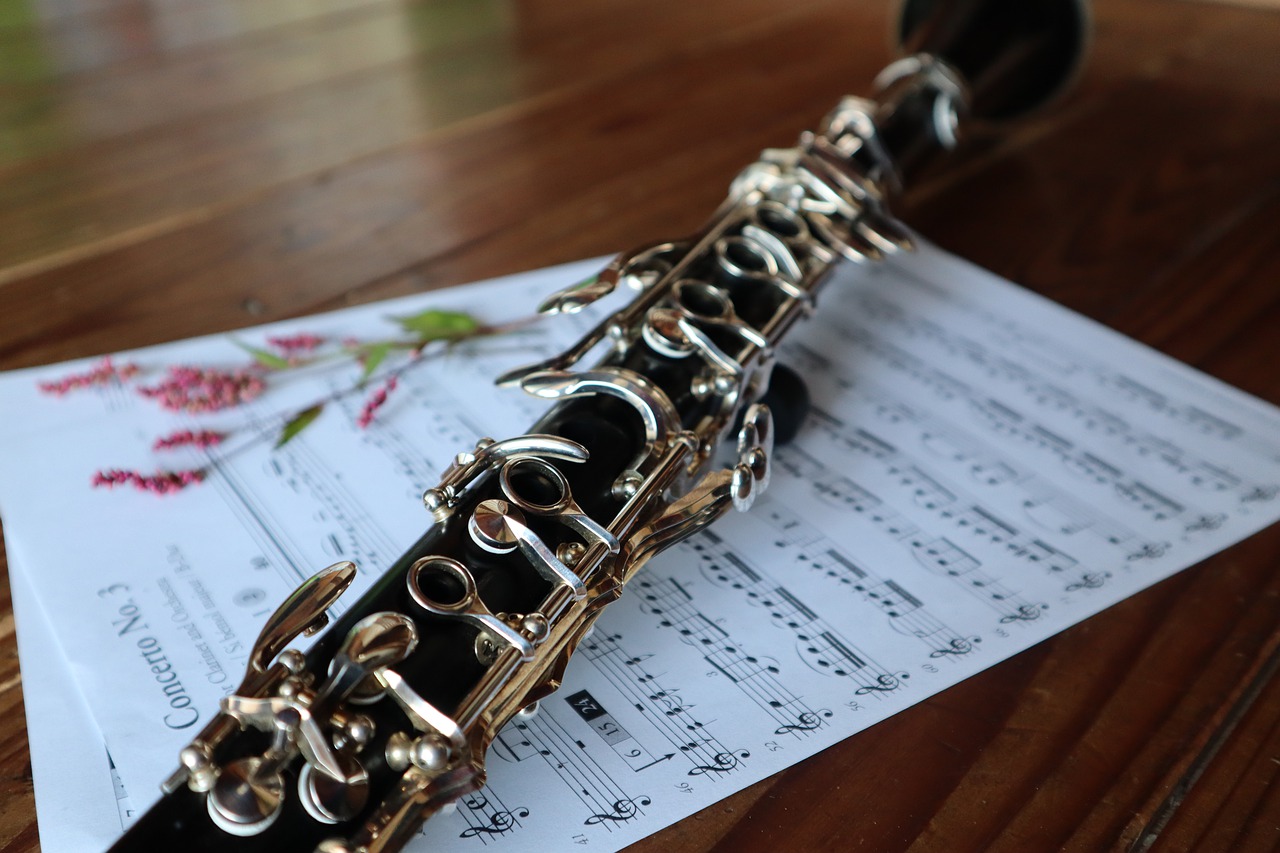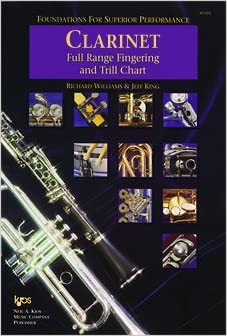- How to Find the Best Sopranino Saxophone - May 31, 2022
- How to Find the Best Contrabass Saxophone - May 30, 2022
- Trumpet Range Guide: Understanding The Entire Trumpet Range - May 19, 2022
Do you want to be a better clarinet player? You should have a clarinet fingering chart explained to you whenever you’re ready to learn a new note.
A fingering chart tells you what keys to close to play certain pitches. To make the most of the chart, consider the clarinet’s range and what each key does.
Bottom Line Up Front: Clarinets have main keys, side keys, and other keys that do different things. The right combinations help you produce music, and a fingering chart helps teach you the notes.
Clarinet Range
One of the first things you should consider when looking at a fingering chart is the clarinet range. The clarinet can play as low as a written E below middle C (E3).
Some low clarinets, such as basses and contrabasses, can go down to an Eb (Eb3) or C (C3) below that. But when it comes to the standard Bb clarinet, E is usually the lowest.
On the other end of the spectrum, the clarinet can go as high as a written C7. You may be able to play higher, but you usually don’t have to play even that high of a note.
The written range stays the same for different types of clarinets. However, the sounding range will change depending on the transposition of the instrument you’re playing.
Left-Hand Clarinet Keys
The clarinet has a lot of keys, and it can be overwhelming to learn what each key does. So I wanted to break it up by the keys that each hand triggers.
You don’t have to learn and memorize all of these keys as a beginner. Over time, you can learn new fingerings slowly, so you’ll soon know what each key does by heart.
When you first learn the clarinet, you’ll probably learn to use your left hand before your right. Of course, your right hand will support the instrument with the thumb rest, but the left hand has a lot of essential keys.
Throat Keys
At the top of the clarinet, you’ll find the keys that help you produce throat tones. These are the written notes G#/Ab, A, and A#/Bb, though they can include other notes when playing trills (I’ll get to that later).
The G# key sits on the left side of the instrument above where your left hand usually is. You’ll reach up to hit that key, and you’ll do the same for the A key, which is on the front of the clarinet.
On the back is what we call the register key, but you can use it to play a Bb in the throat tone register. These notes can sound a bit muffled, but they’re pretty easy to produce, especially for beginners.
Thumb Key
When you look at the back of your clarinet, you’ll see two keys. One of these is a ring over a whole, and that’s the thumb key.
You’ll cover that key for most notes, though not all. It acts similarly to the main keys along the body of the instrument, but it’s on the back.
If you ever see a fingering chart that uses letters and numbers, this key will use the letter “T” for thumb. Since it is an open key, you’ll need to work on putting your thumb in just the right spot to close it.
As you learn the clarion register, you’ll need an even better position because of the next key.
Register Key
Above the thumb key, you’ll find the register key. It’s a bit confusing because you’ll trigger this key with your left thumb as well, but it serves a different purpose.
This key triggers the opening of a smaller key that actually sits higher up on the clarinet. With exceptions, like the Bb throat tone, you’ll need to press this key with the thumb key.
Pressing the register key will raise the pitch of any other fingering by an octave and a fifth. That opens up the clarinet range, and it allows you to access higher notes.
Main Keys
The main keys are those that your first, second, and third fingers press. Like the thumb key, these are open, so your fingers have to hit the correct spot to get the pitch you’re looking for.
Your first and second fingers will press on a ring and close a hole, similar to your thumb. However, the third key is more of a misnomer since it’s just a hole.
The first and second keys use rings because they have to trigger other keys elsewhere on the clarinet. But if you play a low clarinet, such as the bass, all of these keys will be keys and not just rings.
In the chalumeau (low) register, these keys let you play notes like C, D, E, and F. When you add the register key, you’ll get notes such as G, A, B, and C.
Pinky Keys
Your left pinky has to control four different keys, which all play unique notes. The most important is probably the C#/G# key, which lets you play a C# in the low register and a G# up above.
Clarinets have three other left pinky keys that do the same things as three of the right pinky keys. One lets you play low F or the C just above the register break.
Another lets you play a half step below each of those notes, so E or B, depending on the register. The furthest pinky key allows you to play an F#/Gb or a C#/Db.
You’ll use these keys when your right pinky has to cover a different key. They also come in handy if sliding your right pinky isn’t practical during a musical passage.
Right-Hand Clarinet Keys
You may start with the left-hand keys, but the right-hand keys are equally important on a clarinet. They extend the range down and up, depending on if you add a register key.
If you’re just starting, you shouldn’t have to learn the right-hand keys yet. However, it helps to know a bit about what they do so that you can prepare for when you do need to know more fingerings.
Here’s an overview of the right-hand keys and what they do.
Main Keys
Just like your left hand, your right hand is in charge of three keys (ring keys) on the front of the clarinet. You’ll trigger these keys with your first, second, and third fingers.
Assuming you close your left thumb and the three main keys, you can add more of these keys. Starting from the bottom these fingers can trigger G, A, and Bb in the lower register.
You’ll get the notes D, E, and F in the second register. If you play just the second finger but not the first, you’ll get a B in the lower register and an F# in the upper range.
As with the left hand, these keys will be full keys on larger clarinets. But on the Bb clarinet and Eb clarinet, the keys are small enough that your fingers can cover the holes.
Pinky Keys
Just like the left hand, your right hand has four pinky keys to control. Three of the keys trigger the same notes as three of the keys your left hand can play.
As I mentioned, you’ll have to choose which pinky to use depending on the music. Sometimes, it makes more sense to use your left hand, such as if you’re trilling from a low F to F#.
However, your right hand may make more sense if you have a quick switch from a low C# down to a low F#. But you’ll have to use your right pinky to play a G#/Ab in the lower register or a D#/Eb in the second register.
If you buy a clarinet that can play a low Eb, you’ll have a fifth key that your pinky can trigger. So you may have even more options, depending on the model you buy.
Bridge Key
The bridge key is a bit different than other clarinet keys because you don’t press it to play a note. However, it’s the key that helps you line up the upper and lower joints of the instrument.
Lining up the joints is essential for playing certain fingerings. A common example of this is if you use the 1 and 1 fingering for Eb in the chalumeau and Bb in the clarion (upper) register.
There are also some side keys that your right hand triggers to open keys on the upper joint. So if you don’t line up the bridge correctly, you won’t be able to play your clarinet well.
Side Keys
You’ll find four side keys on the right side of your clarinet. The first key lets you play the throat tones a whole step higher than normal.
So a G# would become an A#, an A would become a B, and a Bb would become a C. This comes in handy when you need to trill from a throat tone to a note above.
For example, switching from a Bb to a C quickly is almost impossible, but moving one key is easy. The second side key is also useful for trills, and it raises the pitch of throat tones by a half step.
Another way to use the first and second keys is to achieve a better tone in the throat register. If you ever need to hold one of those notes for a long time, you can do that more easily.
You can use the fourth side key, which is the lowest, to play an Eb in the chalumeau or a Bb in the clarion register. The third key works with the fourth for different alternate fingerings for trills and other purposes.
Standard Fingerings
Beginner clarinet players should start by learning the standard fingerings. At first, you can get away with using the main keys on both hands.
You may need to use the throat tone keys if you want to play a bit higher. As far as pinky keys, start with the keys for F, Ab, and C# in the low register.
Once you master that range, you can start to use the register key to learn higher notes. When you do that, keep in mind that the same fingerings produce different notes, so you can’t rely on your knowledge of the low register.
Trill Fingerings
Like other woodwinds, the clarinet uses a lot of specific fingerings for trills or other quick changes between notes. As you learn trills, consider getting a trill fingering chart to reference.
Some trills are pretty easy, such as from a low Bb to C, since you just move your right-hand first finger. However, a trill an octave above would be impossible with the standard fingerings.
You can use your side keys, but you may not know which to use. Keep a trill chart with you as you first learn so that you can get the correct fingerings.
FAQs about the Clarinet Fingering Chart Explained
Answer: Clarinet fingerings are different between registers because they use a register key. Other woodwinds, such as the saxophone and oboe, use an octave key, so the fingerings are for the same notes.
The clarinet notes sound a 12th higher when you add the register key, and that can be confusing. Don’t be afraid to stick to the low register until you memorize those notes before you add others.
Answer: Some of the easiest notes to learn are the C, D, E, F, and G in the chalumeau register. G is the easiest since you don’t have to close any keys to produce that pitch.
Adding the thumb gives you an F, while adding the first finger gives you an E. The second finger will help you produce a D, and the third will give you a C.
Answer: The clarinet fingerings in the clarion register are very close to saxophone fingerings. However, the chalumeau is a 12th lower, so the fingerings are very different from all woodwinds.
If you play the saxophone, don’t rely on that knowledge to learn clarinet fingerings. Treat yourself as a beginner so that you learn the proper fingerings on your new instrument.
Answer: You can teach yourself the clarinet, and a good fingering chart will help. If possible, I’d recommend taking at least a few lessons with a good clarinet teacher.
The teacher will be able to guide you, and they can recommend a method book. The book will teach you fingerings in a good order so that you learn notes at the right time.
Answer: Clarinets of all sizes will use the same fingerings for the same written notes. Now, those notes will sound higher or lower depending on the type of clarinet in question.
The exception is if you happen to buy a clarinet that uses the Oehler system or Albert system. Those fingerings are slightly different from the popular Boehm system.
Final Note on the Clarinet Fingering Chart Explained
Having a good clarinet fingering chart explained can help beginners and experienced players. While some notes seem intuitive, others may require alternate fingerings, especially for trills.
Be sure you understand what each key does and that you have a fingering chart to reference. Soon enough, you’ll know all of the fingerings by heart, so playing clarinet will be a breeze.
Looking for more interesting readings? Check Out:





